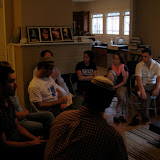
Thank you to all our supporters, friends, funders and guests. There would be no article, no dinners, movie nights and trips without your continued interest and participation. A shout-out to Bruce Nolan for spending time with us in writing the great article. And last but not least, thank you to the Moishe House Foundation for being bold enough to offer New Orleans this opportunity

Rabbi Uri from Beth Israel shared a fantastic lesson with Moishe Nola Monday, July 27th on the history, interpretations and teachings on Tikkun Olam - perfecting/fixing the world. Pictures can be seen here:
 |
| Jewish learning #2 With Rabbi Uri |
For the selected teachings see the following links. Please email us if you want to be added to the list and help us plan the next series of classes.
Overview of Tikkun Olam Origin and Interpretation
Elements of Rabbi Kook Text - Not exact text used but good supplement.
Text Used Last Night (see below provided by Rabbi Uri)
ORIGINS OF TIKKUN OLAM
A discussion about the roots of social justice in Jewish tradition
Lights of Holiness by Rabbi Abraham Isaac HaCohen Kook (early 1900s)
“Two Values of Perfection”
We understand in the Absolute divine perfection, two values of perfection.
One value of perfection, because of its greatness and completeness, has no relationship to any growth. However, if there was not a possibility of growth, this itself would be a deficiency. Because the Perfection which progresses and increases consistently has no extra, transcendental pleasure - a certain height that we yearn for, to grow from power to power, and therefore the divine perfection could not miss this advantage for growth.
Therefore there is to divinity the ability to create, a no end actualization of worlds, that continues in its full value and ascends, and therefore, what gives life to the soul is this constant power to ascend, this is its divine foundation, the call to actualize and improve.
To the extent that science progresses and establishes itself upon the principle of evolution, it progresses and comes closer to the clearest divine light, the highest vision.


